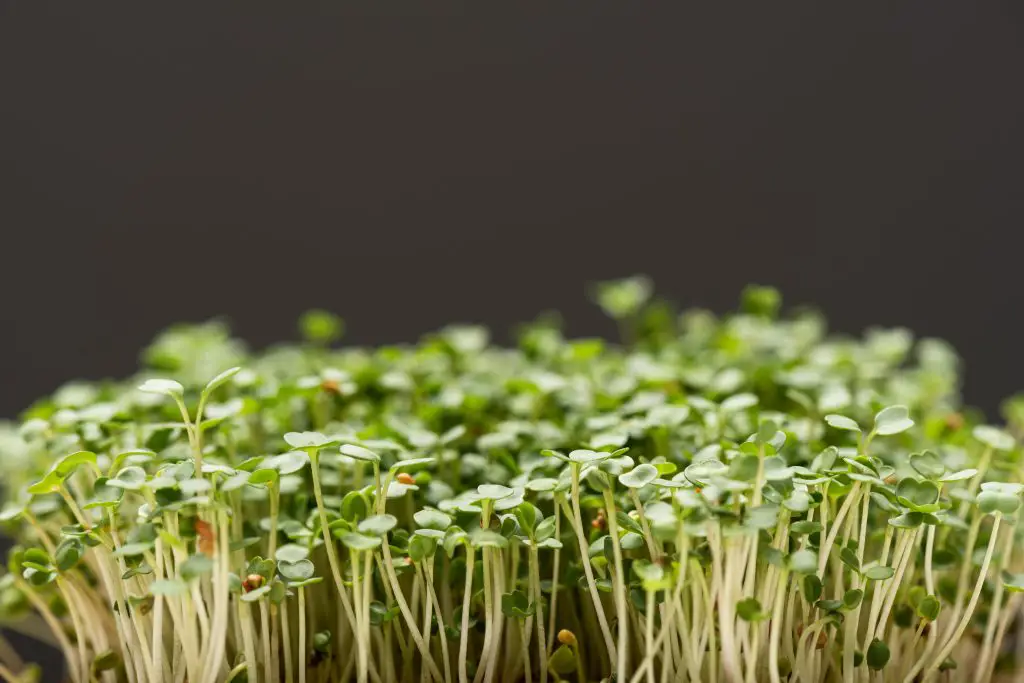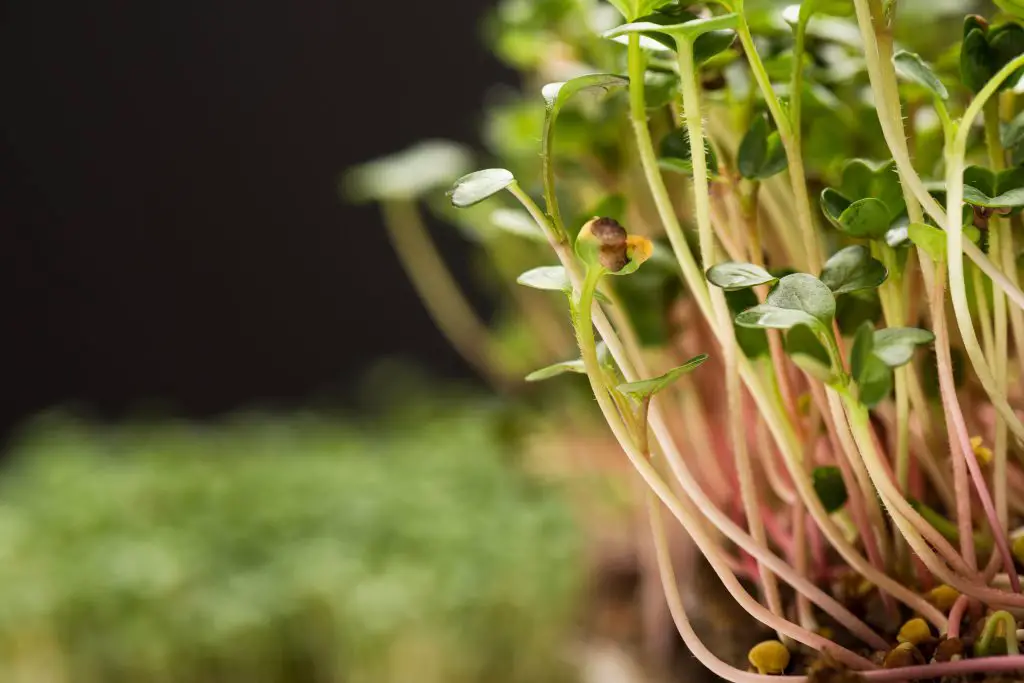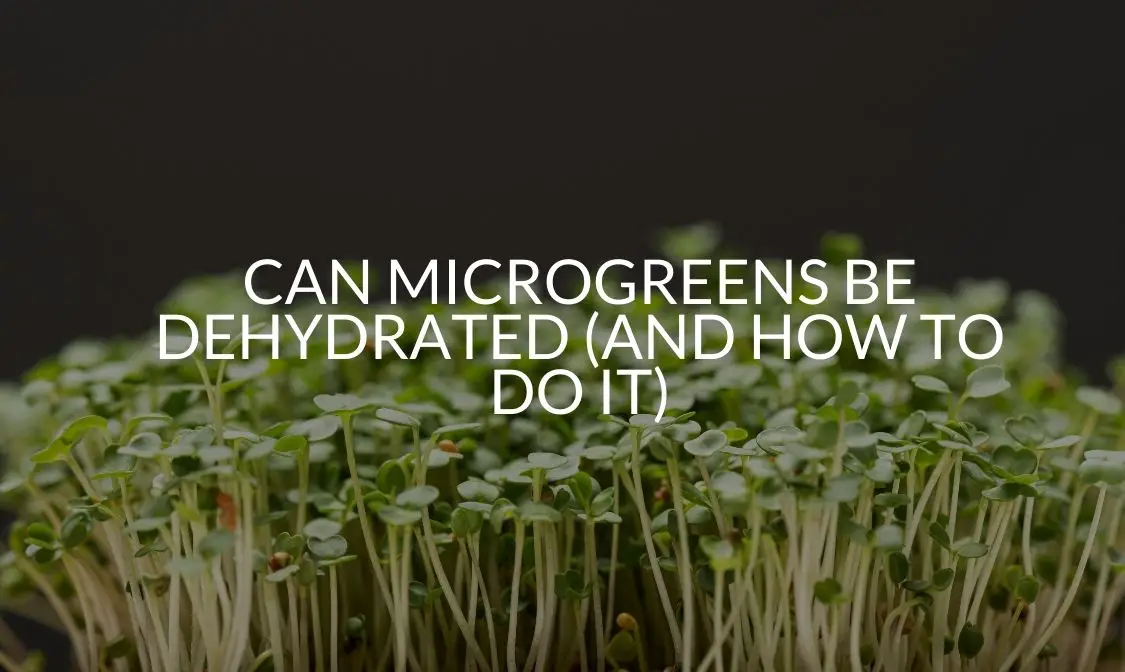Can microgreens be dehydrated? This is one thing a lot of people wonder about when they plant their own gardens. Microgreens can be dehydrated, which makes it easier to store if you have an abundance at harvest time.
Microgreens have become incredibly popular because they are incredibly easy to grow and packed full of nutrition. Not to mention, they add so much flavor to any dish they are added to. People don’t have to use a lot of microgreens to see how beneficial they are. If you plant your own microgreen this season, you will have a lot of options when it’s time to harvest them.
Can You Dehydrate Microgreens?
Yes, microgreens can be dehydrated just like any other vegetable. There are many different ways you can use dehydrated microgreens in the kitchen. Microgreens grow incredibly fast, so if you grow your own you’ll likely have a new supply every week. Dehydrating them makes storing the microgreens a lot easier so they don’t go to waste.
How Do You Dehydrate Microgreens?
How can microgreens be dehydrated? You can do this yourself in the kitchen as long as you have a food dehydrator, oven, or air fryer.
Dehydrating Microgreens In The Food Dehydrator
- Preheat your food dehydrator to 110 degrees F.
- While the dehydrator is getting ready, use a salad spinner to thoroughly wash and dry the microgreens.
- Take the microgreens out of the salad spinner and pat them down with paper towels to ensure there is no extra moisture leftover.
- Spread out all of the microgreens evenly on the dehydrator tray.
- Allow the microgreens to sit in the dehydrator for 3 to 6 hours. The time will depend heavily on the temperature.
- When the microgreens are finished, they will be 1/3 the size.
- Allow the microgreens to fully cool down before storing them to prevent mold build-up.
Dehydrating Microgreens In The Oven
- Preheat your oven to the lowest temperature.
- Spread the microgreens out evenly on a baking tray.
- When you set the baking tray in the oven, don’t close the door completely. Leaving it open slightly will create the necessary amount of air circulation to prevent moisture from getting into the oven. When you dehydrate microgreens you’ll want to limit any chance of exposure to moisture.
- Allow the microgreens to sit in the oven for 1.5 to 3 hours. Make sure to check on them continuously so they don’t burn.
Dehydrating Microgreen In The Air Fryer
Modern air fryers have temperature settings and if you have an air fryer that has a low-temperature setting, you may be able to dehydrate your microgreens in there. However, this will only work if the air fryer has a good ventilation system. If you are unsure, always check the user’s manual to confirm.

Are Dehydrated Microgreens Good For You?
What you may not have known was that dehydrated vegetables still contain enough nutrients to pass the raw food diet test. This means that there are a lot of nutritious benefits that come along with eating dehydrated microgreens. You can simply add them to anything you eat to make it more nutritious.
Good Source Of Minerals
Microgreens are praised for their nutrients, and even when dehydrated, these little green stems are loaded with minerals. They are an excellent source of magnesium, sodium, calcium, and potassium. Microgreens are also a great source of fiber and healthy carbohydrates.
Vitamins Don’t Diminish Either
Dehydrated microgreens are also an excellent source of Vitamin A. They always have a decent amount of Vitamin C, however, some of it does get slightly reduced compared to when you eat raw microgreens.
Low In Calories
One thing to know about microgreens is that they may be small but they have big flavor. The flavor doesn’t disappear when they get dehydrated. This means that you won’t need to add anything to the microgreens, like salt, to make them taste good. Since nothing gets added to them, the microgreens remain low in calories for a light snack.
How Do You Use Dehydrated Microgreens?
Once you have dehydrated your microgreens, you won’t be short of ideas of how you can use them. Just in case you need some tips, here are some excellent ways to use microgreens:
Homemade Seasoning
Dehydrated microgreens are packed with flavor, so you can use them to season your food. Not only will you meal be tastier, but it will be extra nutritious. Certain microgreens, like radish or chia, have a nice spicier flavor that compliments many dishes. Here are some dishes that you can flavor with dehydrated microgreens:
- Soups
- Sandwiches
- Meats
- Eggs
- Sauces
- Salads
- Casseroles
- Tea
- Poke bowls
Breakfast Smoothies Additive
A smoothie is a great option for breakfast because it’s filling and full of healthy ingredients. Sometimes people sneak green ingredients, like spinach or avocado, into their smoothies because it gives extra nutrition without affecting the taste. Microgreens do have more flavor, but since you don’t need to add much to the smoothies to give it a boost, it doesn’t affect the flavor.
Use As Garnishes
If you’re about to snap a picture of a meal you worked hard to put on Instagram, you may want to add a bit of decorative flare to the plate to make it look nicer. The same can be said when you’re preparing a meal for company. Dehydrated microgreens are just as beautiful as they are nutritious. They make a really attractive garnish on any plate.
DIY Green Powder (Save A Lot Of Money)
Green powder is a very popular ingredient among health conscious people. This ingredient can cost quite a bit of money when you purchase it from a health food store. The good news is, you can save a lot of money by making your own green powder. Simply grind up the dehydrated microgreens until they are a fine powder.
1/4 tablespoon of green powder can go a long way. If you consume 1/4 tbsp of green powder, it’s the equivalent of eating an entire handful of fresh microgreens. Just one serving per day could have a lot of health benefits.
How Do You Store Dehydrated Microgreens?
There are many different ways you can store your dehydrated microgreens to keep them good. Your main prerogative when storing dehydrated microgreens is to keep them free of moisture. Even the slightest amount of moisture can ruin all the work you put into dehydrating those microgreens.
If you can’t eat all of your fresh microgreens before they go bad, dehydrating them and storing them is a great way to prevent them from spoiling. This way none of your harvest goes to waste, and you’ll have something nutritious in your cupboards all the time. Let’s take a look at the different ways you can store dehydrated microgreens.

How Long Can Dehydrated Microgreens Be Stored?
If you make an abundance of dehydrated microgreens, you won’t have to worry about throwing them out. If you store them properly, dehydrated microgreens could be stored for 8 to 10 years. However they must be sealed and stored in a temperature around 70 degrees F.
Air Tight Container
The best way to store microgreens is in an air-tight container. This will help them maintain a longer shelf life. Make sure the lid to the container you store them in is able to fully seal so no air gets inside. If you don’t have an air-tight container, a jar will work as well.
Tip: If you don’t hear the lid to your container click into place, it may not be tight enough. You should use a different container to keep your dehydrated microgreens in so they do not spoil. Make sure there are no holes or piercings anywhere on the container and that it has been fully dried before storing the microgreens.
Room Temperature
Don’t place your dehydrated microgreens in the fridge or freezer. You will want to keep them at a steady temperature. If you place them in the fridge, they will be exposed to moisture. This will completely ruin your dehydrated microgreens. If you place them in the freezer, they will still be edible but will have a slimy texture that’s very unappetizing.
Final Thoughts: Can Microgreen Be Dehydrated?
If you’re interested in learning about gardening, microgreens are very easy to grow. Even people who have never had a green thumb can have success growing microgreens. You may be so successful growing microgreens that you have more than you can eat. If this is the case, you should consider dehydrating those extra microgreens. This way you will have more than enough to feed yourself all year long.
Microgreens are incredibly healthy because they’re loaded with vitamins and minerals that your body needs. There are so many different things that you can do with dehydrated microgreens, including making your own green powder from scratch. As long as you store the microgreens properly, they could last you nearly a decade. If you want to make healthier eating simpler to follow, keeping dehydrated microgreens on hand is a great start.



